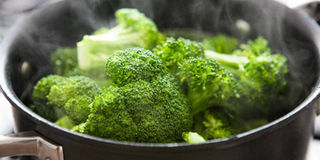Right ways to cook food to retain nutritious value

Steamed broccoli PHOTO | FILE
What you need to know:
One should opt for cooking methods that require shorter periods of cooking and on low temperature.
Faustina Msula, a mother of three loves cooking for her family and ensures her children eat healthy. Mrs Msula believes that eating nutritious keeps her family shielded from contracting diseases. She tells Your Health, “I stopped buying junk or processed foods, which I think may not be well prepared.”
Mrs Msula gets fresh fruits and vegetables from a nearby market and has also made an effort in planting few vegetables in her home garden to help her save cost and eat organic.
Some of us might be regular buyers of fresh vegetables, like Mrs Msula, but for instance mushrooms that are deep fried or broccoli that are cooked in cheese sauce doesn’t really offer a host of nutritious benefits. An example is echoed by Mrs Msula herself, “Breading meats and veggies is completely unnecessary and a terrible cooking habit. Breading is usually full of simple carbohydrates and provides you little nutrition. If you do bread a cutlet, swap out the white crumbs and flour for whole-wheat bread crumbs.”
What is healthy cooking?
Attaining a healthy lifestyle involves eating healthy and being physically active, reiterated by nutritionist Neema Shosho. She adds that people need to always to strike the balance between the two otherwise we will continue seeing ourselves struggling with obesity, overweight, diabetic, hypertension and many other diet related non communicable diseases
“When we talk about healthy eating it is important to also consider healthy cooking methods. One might ask so what is that all about, cooking is just cooking! It is worth noting that cooking methods can change your healthy food to unhealthy one and yes cooking methods can affect nutrients of your food and torment your health,” adds Ms Shosho. Depending on the cooking methods, vitamin C and D, vitamin A, D, E, K and minerals such as sodium, potassium, magnesium and calcium are often affected. Let’s look at some of the healthy and unhealthy cooking methods explained by Ms Shosho.
Frying – Locally known as ‘kukaanga’, this involves cooking food in a large amount of fat, usually oil, at a high temperature. Although fried foods taste yummy, it is important to note that when oil is heated to a high temperature for a long period of time, toxic substances called aldehydes that have been linked to increase risk of cancer and other diseases are formed.
Boiling – A quick and easy method, commonly practiced in both urban and rural areas. Boiling is a safe way of persevering some nutrients but it can dissolve vitamins and minerals in some foods such as vegetables.
Steaming – This method of cooking keeps vitamin C and D in your food and is named as one of the best cooking methods for preserving nutrients. The only issue with steaming method is on the taste, most people don’t find steamed food tasty. You’ll often hear, ‘steamed food is for sick people, tastes like medicine.’
Grilling and broiling - Although this method provides great flavour to the food, it reduces B vitamins. Grilling also just like frying generates possible cancer causing substances. There are people who never miss nyamachoma and other choma foods hence be watchful!
Take away from the nutritionist
1. Select cooking methods carefully depending on the type of the food you intend to cook.
2. Mix different cooking methods, don’t stick to one over and over again.
3. Avoid cooking methods that involves cooking for very long time, using high temperature and lots of fats and oil.
4. If possible opt for cooking methods that requires shorter periods at lower temperatures.
5. Remember there is no one cooking method that retains all the nutrients. However, don’t opt for methods with tremendous effects on the nutrients and cancer causing potential.
[email protected]




